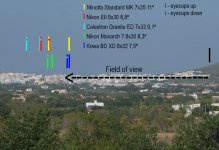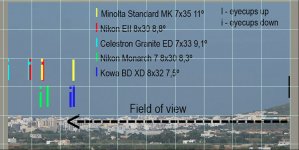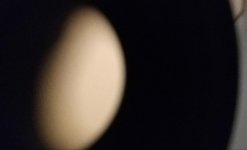Over the years I’ve come to appreciate binoculars, from the beautiful (and closer!) image they can provide of birds to the facts about the way they work, the differences between models, formats, brands or even the mere “feel factor” in the hand (I'm sure many forum members will share the same fascination).
Some things are more important for me than others (just like for everybody else I guess). I tend to like a wide field of view, but then… Some time ago I bought a classic 7x35 13º extra wide field binocular (it was a Japanese JB 146, if I remember correctly). The much anticipated view through them left me a bit cold (to say the least), I just couldn’t use the monstrous FOV simply because there was a certain point where my eyeballs were literally touching the glass on the eyepieces long before I could even reach to see the field stop. That left me thinking; I did the same test with the 8x30 EII (and it’s more than respectable 8,8º and I got a similar result; even with the eyecups folded down there was no way I could see the field stop (and thus make use of the entire 8,8º FOV). Well, then I forgot about that and lived happily ever after.
Last week I saw Minolta 7x35 Standard MK 11º (a binocular I’ve been very curious about for quite a while, after having read good critics both here and also in Cloudy Nights). I won’t go into detail about the optical performance of the Minolta (nor am I skilled to give anything but a personal experience). The Minolta looks more user friendly than the old JB-146, so I assumed it could show more of the promised 11º FOV. However, the experience let me down again. So I devised a simple test to see how much FOV I can actually see from a series of wide field binoculars (and other binoculars I have at hand): Minolta Standard MK 7x35 11º, Nikon EII 8x30 8,8º, Celestron Granite ED 7x33 9,1º, Nikon Monarch 7 8x30 8,3º, Kowa BDXD 8x32 7,5º.
NB* This is a COMPLETELY UNSCIENTIFIC test not to be taken too seriously. Nothing more than a excuse to spark conversation and learn more in the process. I have a good eyesight and have never used reading/prescription glasses. At 45 I still have a quite acute eyesight. I tend to use the eyecups all the way up on my binoculars, with some exceptions, where I can go down by one point, like in the 8x32 Zeiss Victory FL or the 8x30 Nikon Monarch 7 8x30. When I want to enjoy a huge FOV I usually twist them down for the sheer pleasure of the experience.
I have put on a tripod the mentioned binoculars and selected a landmark on the right hand side extreme (the side of a building in cream colour, marked with a black vertical line). As I tried all the binoculars, I placed the selected landmark always on the very edge at the right of my view, "the rightmost” point I could see without “hoovering” above the eyepiece, simply by looking “naturally” at the image in front of my eyes. Comparing my results with care I have noted the landmark I could see on the left most point of the FOV for every binocular. I have used a different colour for each binocular, and I have marked the limit of what I could see with the eyecups all the way up (l) and folded/twisted down (i). You can check the image while reading the results for a “full experience” Let’s go:
Minolta Standard MK 7x35 11º. Yellow line. With eyecups up the feeling is of very strong vignetting and a bit of a “looking through a pipe”, quite disappointing actually. Folding the eyecups down increases the experience, but you get the feeling that there is so much more FOV there that you will never be able to enjoy. The view is pretty uncomfortable, since you have to brush your eyelashes against the eyepiece in order to get a wide FOV. If I lean towards the sides (a lot) I can get to see the field stop, really hidden away, but if I do this and get a glance of the field stop the image I can see is an unusable crescent.
Nikon EII 8x30 8,8º. Red line. Quite surprisingly, with eyecups up I can see nearly everything I can see with the Minolta with folded eyecups (this is a revelation), and obviously the viewing experience is so much more relaxed and pleasant. Eyecups down and I can see way more than I get with the Minolta. However, the difference between eyecups up and down is nowhere near as big as in the Minolta.
Enter a contemporary roof, the Celestron Granite ED 7x33 9,1º. Light blue line. the only porro contender in the super wide field fight. Surprise, surprise, eyecups all the way up I can see so much more than with any of the previous contenders. Actually, I can see a tad more than with the EII with folded eyecups (another revelation). Again, I am not judging optical performance at the field or sweet spot, I’m only talking about how much FOV I can see today with my eyes trying to be as neutral as I can. I fold down the eyecups and the width of the field is magnificent. For the first time, I can see the field stop on both sides, so I’m making use of all the FOV the device is able to provide.
The underdog: Nikon Monarch 7 8x30. Green line. At 8,3º these should pose no threat to the previous specialists in wide FOV, or should it? Well, I was in for a big surprise: eyecups all the way up, I can nearly see the field stop and the very relaxed view leaves me very close to the EII. Eyecups down and I can see the field stop, the width does not match that of the EII. In this case, the difference between having the eyecups up or down is pretty narrow.
Wildcard: Kowa BDXD 8x32 7,5º. Dark blue line. With an AFOV of 56,5º these seem out of place in this test, but let’s see what happened. With a “limited” 7,5º I can see the field stop if I try hard, even with eyecups up, but again, the goal of this test is to measure what I can see looking in a “natural and relaxed way” through the binoculars. To my surprise, measuring the landmarks on the skyline of the town San Antonio (Ibiza), I can actually see the same FOV than with the Minolta with eyecups up. I twist the eyecups down and there’s hardly any difference, I can clearly see the field stop and maybe enjoy a tiny little more width of field.
So, to my surprise, the only roof (Celestron at 9,1º) provided the widest and easiest to obtain FOV and the obvious favourite (the Minolta at 11º) was defeated without mercy even by a small and “humle” roof (the M7) with its modest 8,3º and unexpectedly matched by a 7,5º small roof. All the three roofs showed their field stops more easily than the porros. Does anyone know if this is something typical of roofs because of the nature of their construction? Or was it simply the selected devices?
Any comments or ideas are more than welcome.
Some things are more important for me than others (just like for everybody else I guess). I tend to like a wide field of view, but then… Some time ago I bought a classic 7x35 13º extra wide field binocular (it was a Japanese JB 146, if I remember correctly). The much anticipated view through them left me a bit cold (to say the least), I just couldn’t use the monstrous FOV simply because there was a certain point where my eyeballs were literally touching the glass on the eyepieces long before I could even reach to see the field stop. That left me thinking; I did the same test with the 8x30 EII (and it’s more than respectable 8,8º and I got a similar result; even with the eyecups folded down there was no way I could see the field stop (and thus make use of the entire 8,8º FOV). Well, then I forgot about that and lived happily ever after.
Last week I saw Minolta 7x35 Standard MK 11º (a binocular I’ve been very curious about for quite a while, after having read good critics both here and also in Cloudy Nights). I won’t go into detail about the optical performance of the Minolta (nor am I skilled to give anything but a personal experience). The Minolta looks more user friendly than the old JB-146, so I assumed it could show more of the promised 11º FOV. However, the experience let me down again. So I devised a simple test to see how much FOV I can actually see from a series of wide field binoculars (and other binoculars I have at hand): Minolta Standard MK 7x35 11º, Nikon EII 8x30 8,8º, Celestron Granite ED 7x33 9,1º, Nikon Monarch 7 8x30 8,3º, Kowa BDXD 8x32 7,5º.
NB* This is a COMPLETELY UNSCIENTIFIC test not to be taken too seriously. Nothing more than a excuse to spark conversation and learn more in the process. I have a good eyesight and have never used reading/prescription glasses. At 45 I still have a quite acute eyesight. I tend to use the eyecups all the way up on my binoculars, with some exceptions, where I can go down by one point, like in the 8x32 Zeiss Victory FL or the 8x30 Nikon Monarch 7 8x30. When I want to enjoy a huge FOV I usually twist them down for the sheer pleasure of the experience.
I have put on a tripod the mentioned binoculars and selected a landmark on the right hand side extreme (the side of a building in cream colour, marked with a black vertical line). As I tried all the binoculars, I placed the selected landmark always on the very edge at the right of my view, "the rightmost” point I could see without “hoovering” above the eyepiece, simply by looking “naturally” at the image in front of my eyes. Comparing my results with care I have noted the landmark I could see on the left most point of the FOV for every binocular. I have used a different colour for each binocular, and I have marked the limit of what I could see with the eyecups all the way up (l) and folded/twisted down (i). You can check the image while reading the results for a “full experience” Let’s go:
Minolta Standard MK 7x35 11º. Yellow line. With eyecups up the feeling is of very strong vignetting and a bit of a “looking through a pipe”, quite disappointing actually. Folding the eyecups down increases the experience, but you get the feeling that there is so much more FOV there that you will never be able to enjoy. The view is pretty uncomfortable, since you have to brush your eyelashes against the eyepiece in order to get a wide FOV. If I lean towards the sides (a lot) I can get to see the field stop, really hidden away, but if I do this and get a glance of the field stop the image I can see is an unusable crescent.
Nikon EII 8x30 8,8º. Red line. Quite surprisingly, with eyecups up I can see nearly everything I can see with the Minolta with folded eyecups (this is a revelation), and obviously the viewing experience is so much more relaxed and pleasant. Eyecups down and I can see way more than I get with the Minolta. However, the difference between eyecups up and down is nowhere near as big as in the Minolta.
Enter a contemporary roof, the Celestron Granite ED 7x33 9,1º. Light blue line. the only porro contender in the super wide field fight. Surprise, surprise, eyecups all the way up I can see so much more than with any of the previous contenders. Actually, I can see a tad more than with the EII with folded eyecups (another revelation). Again, I am not judging optical performance at the field or sweet spot, I’m only talking about how much FOV I can see today with my eyes trying to be as neutral as I can. I fold down the eyecups and the width of the field is magnificent. For the first time, I can see the field stop on both sides, so I’m making use of all the FOV the device is able to provide.
The underdog: Nikon Monarch 7 8x30. Green line. At 8,3º these should pose no threat to the previous specialists in wide FOV, or should it? Well, I was in for a big surprise: eyecups all the way up, I can nearly see the field stop and the very relaxed view leaves me very close to the EII. Eyecups down and I can see the field stop, the width does not match that of the EII. In this case, the difference between having the eyecups up or down is pretty narrow.
Wildcard: Kowa BDXD 8x32 7,5º. Dark blue line. With an AFOV of 56,5º these seem out of place in this test, but let’s see what happened. With a “limited” 7,5º I can see the field stop if I try hard, even with eyecups up, but again, the goal of this test is to measure what I can see looking in a “natural and relaxed way” through the binoculars. To my surprise, measuring the landmarks on the skyline of the town San Antonio (Ibiza), I can actually see the same FOV than with the Minolta with eyecups up. I twist the eyecups down and there’s hardly any difference, I can clearly see the field stop and maybe enjoy a tiny little more width of field.
So, to my surprise, the only roof (Celestron at 9,1º) provided the widest and easiest to obtain FOV and the obvious favourite (the Minolta at 11º) was defeated without mercy even by a small and “humle” roof (the M7) with its modest 8,3º and unexpectedly matched by a 7,5º small roof. All the three roofs showed their field stops more easily than the porros. Does anyone know if this is something typical of roofs because of the nature of their construction? Or was it simply the selected devices?
Any comments or ideas are more than welcome.
Attachments
Last edited:









